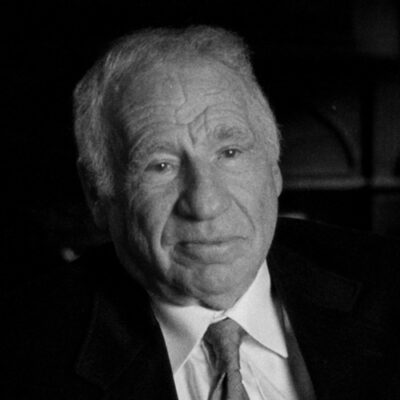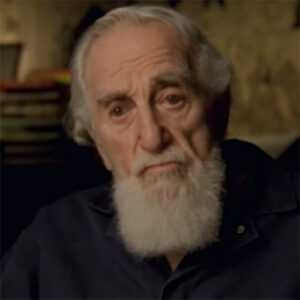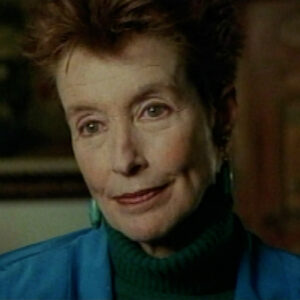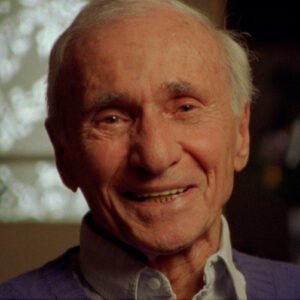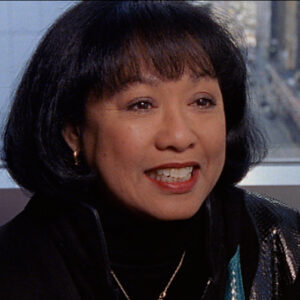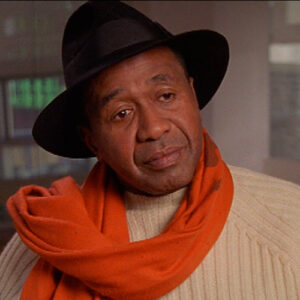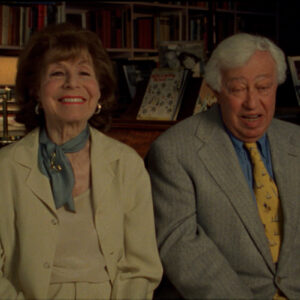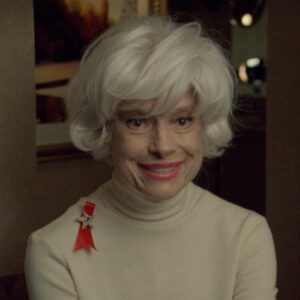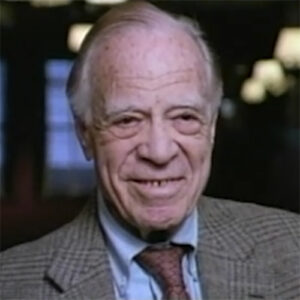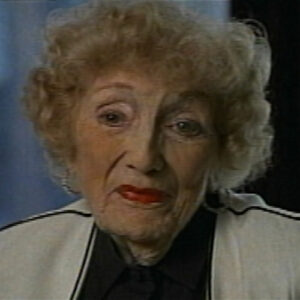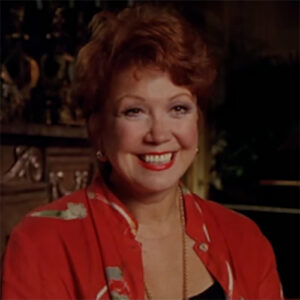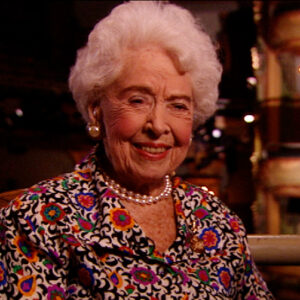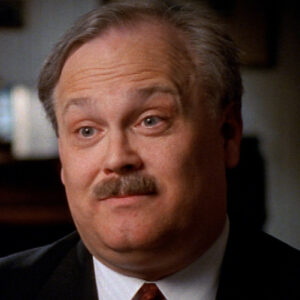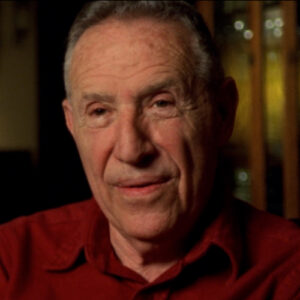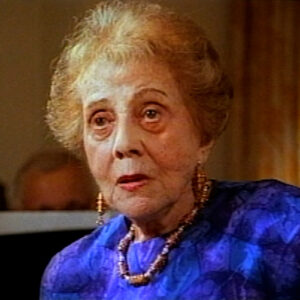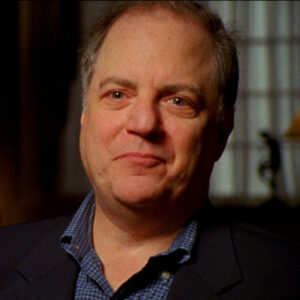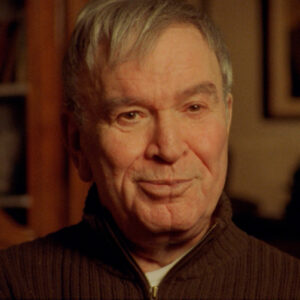Michael Kantor: It’s an unusual song. Radio stations don’t want to play it. And what does JJ say?
Robert Kimball: Well, J.J. Had two reactions. He couldn’t remember the name of the song. He called it Buddy, Can You Spare Ten Cents, is what he thought was the title. And when asked what he though of the songs, he said, to him it sounded sorbid. 1932, there was a review called Americana, which had songs by E.Y. Harburg and Jay Gourney, and one of the the songs was Brother, Can you Spare a Dime, one of the great songs of American experience, really. J.J. Schubert reacted to the song in the following way. He, first of all, couldn’t remember the name of it. He referred to it as Buddy, Can You Give Me Ten Cents, or something like that. And then, according to Yip Harburg, his reaction to the songs was perplexing. He described the song as sorbid. After World War I, there was a huge excitement on Broadway that was reflected in the big reviews of the time. There were intimate reviews even back in the 20s, but they didn’t become significant until the 1930s or maybe 1929, 1930. But in 20s it was the age of Ziegfeld, George White. Others like the Schubert’s, Earl Carroll. They had shows that were associated with them, the Siegfeld Follies, lavish, opulent, hugely populated cast. We’re talking 150, 200 performers on the stage. They were amazing. If you won a beauty contest, and the Miss America contest began in the early 20s, Earl Carol would put you under contract to appear in the Vanities. It was a tremendous opportunity for social mobility, particularly from the young women from small towns in America who, you know, left to work at the dime store to find a more exciting life, a more rewarding life in all kinds of ways, monetarily by meeting really wealthy guys and by working in reviews. But the review was the principle form of musical theater entertainment during that decade. Many of the great stars appeared in reviews gradually. In 1929, stocks went to their highest levels. The frenzy which accompanied much of the decade, certainly in the entertainment world, was at a peak. Broadway was at its most productive, its most abundant. You had as many as 250 shows in a single season, over 50 of the musicals. You also had in the changing entertainment world the coming of the talking pictures, the jazz singer opening in 27, theaters closing down to rewire for sound. Reopening in 29. You have a time of incredible explosion in the American musical. And it is stopped in a way, but it isn’t stopped. We think of it as being totally shut down by the crash of October 1929. Broadway lays an egg, variety. It did. It was a dramatic event. It staggered everyone across the country and around the world. But shows didn’t close. People didn’t go out of work immediately. Yes, a lot of people jumped out of buildings. People lost their money on the stock market. But the world went on. It was only gradually over the next few years that the economic climate worsened. Unemployment increased. Bread lines and soup kitchens and bonus marches and a worsening of the economic world throughout Western society. It was a terrible, terrible time. It got worse in 30, got worse than 31, and even worsened in 32 and into 33 with the coming of Roosevelt. Roosevelt’s arrival didn’t change things immediately. Yes, he closed the banks and started the 100 Days program of economic stimulus. Much began to change. But what we had was a slow loss of momentum on Broadway. Part of it, and it’s difficult to know how much, can be attributed to the talking pictures and the growth of this new industry, which attracted performers, writers, producers to the West Coast to get involved in this new world. Shows began to run. And then there began to be fewer of them, and theaters began to close. The process is gradual. But within three or four years, you look at the number of shows that had appeared on Broadway in the late 20s and the number shows on Broadway in the 30s, 1932, 33, you see a dramatic drop in the production, number of show that endure, and in the whole world. Virtually everyone has gone to California who wrote musical theater scores, except Cole Porter. The Gershwins had gone out in early 31, I believe it was, late 30 to work on Delicious. They came back. Rodgers and Hart left in 31 after America’s Sweetheart, were gone until late 34 to begin work on Jumbo when they came back over three years, a time that Richard Rodgers described as wasted for him, except that he learned how to play tennis. It was a very, very tough time, but it was gradual rather than immediate.
Michael Kantor: How did they change in the 30s?
Robert Kimball: The most dramatic way in which musicals changed in the 30s is that they disappeared largely. There were many fewer of them. Very few shows were successful. The ratio is usually one in five. If you have five shows opening in a season, typically one of the five will have some sort of success. So with many fewer shows opening, that was one of major changes. The other change is that the shows that always reflected the times. In the 20s, if you look at the shows of the Silver, Brown, and Henderson, for example, they’re about good times, about people passing footballs and winning girls, about a guy sinking a pot or winning a prize fight or flying across the country. That stops ending. That’s no longer true. You look in 1930, for examples, and you look the songs of 1930, you’ve got a song like Love for Sale by Cole Porter and the New Yorkers. That is not the kind of song you would encounter in the 20s. You get 10 Cents a Dance by Rodgers and Hart and Simple Simon. That is certainly not the song you would encounter the 20’s. You’ve got a great song by Deetson Schwartz, which is used wonderfully in John O’Hara’s book Appointment in Samara, Something to Remember You By. His singer, Helene Holman, the roadside singer, sings that song, and you remember it very well. She’s Libby Holman. She’s Helen Morgan, but she’s a combination. You begin to get a very different kind of world. I think the show that begins to show the differences is Girl Crazy, the Gershwin’s big hit of the fall of 1930. You have the old exuberance carried up to a magnificent level in a song like I Got Rhythm, but you get a song like Boy What Love Has Done To Me, and Sam and Delilah. They are sadder, sort of more bittersweet songs, and of course, above all, a great, great ballad, but not for me. They’re writing songs of love, but not for me. That’s the change. In the kinds of shows that were done, there is much more social commentary. There’s much more relationship to the bad times. And I think you get that in a song like Brother, Can You Spare a Dime? And you increasingly get it in the reviews, the intimate reviews. You’ve got a feeling of the times in the labor movement in Pins and Needles by Harold Rolme. You get the work of Mark Blitstein and the Credible Rock and many other writers who are bringing a new vision.
Michael Kantor: How does this kind of satire reflect the times of the Great Depression? I mean, clearly there’s anger at the political system that they’re feeding on. So I think that… Let’s place that show in the time.
Robert Kimball: That’s a good question. It’s about the Hoover administration, isn’t it? It’s not about FDR.
Michael Kantor: What’s of the icing about, and how’s it a great achievement? Settle or roll it.
Robert Kimball: Of the I Sing, which I and many other people feel was the Gershwin’s greatest musical show, opened in late 1931, and was the longest running show and their most successful show. It captured the Hoover administration. Herbert Hoover elected in 28 at a time of prosperity, 1932 is turned out of office. Does anybody remember Hoover’s Vice President? Probably not. So fun was poked by Kauffman and Riskin at the political scene of the 20s. And they came up with this wonderful idea of having the candidate run on a platform of love, a beauty contest, a perfect emblem of the twenties. And the winner is to marry the presidential candidate. What a wonderful idea. And what a great score came out of it. The humor of that show still resonates. It’s still. Tells you something when you poke fun at the Vice President and you poke at love and sex in the White House, subjects that have not exactly left us in all these decades that remain extraordinarily part of the American landscape. So the show was timely, it was exuberant, it is a rollicking score from beginning to end. The most energized. Thrilling of the Gershwin shows, I think. I think even barely topping Girl Crazy, which is pretty darn great. And I would put of the, I say, and I love Let Him Eat Cake, the sequel. I don’t think it’s quite at the level of Sing, although it has great, great moments in it, and I think a wonderful score as well. But Sing is fantastic. It won the Pulitzer Prize for Everyone But George in 1932. Ira Gershun told me it was the only time he ever quarreled with his brother. What happened is that the award went to Kaufman. Rysken and Ira Gershwin and excluded George because it was only about words. It was about a play winning an award for best play and this was the first musical to win the award. And Ira didn’t want to take up his award, didn’t wanna receive it and George yelled at him. Ira said, my brother was mean to me about it. He said, you have to pick up your award. And Ira said I don’t want to because you should have gotten it before any of us. The battle went back and forth and ended, Iris said, a few days later because our father died. May of 1932 and the quarrel came to an end because we were worried about we had to deal with the reality of our lives that our dad was gone.
Michael Kantor: What made Cole Porter’s song so appealing in the broadest sense in The Depression?
Robert Kimball: Long pause. In the 1930s, when people felt the anguish and pain of the economic privation, It’s ironic, isn’t it, that a man who was wealthy, sophisticated, could reach people in a way that other people couldn’t. And I think it was that even with all his money, he wrote tellingly about pain. Transitions in life, abrupt and other. He wrote about the fact that even with money, you are not happy. He wasn’t. Why should other people be happy? And now the whole country is affected by it. And they’re responding to him. They respond most tellingly to one song, a song called, You’re the Top, which is a different message. You’re The Top tells people in 1934, yeah, we’re all feeling lousy, Now maybe it’s time to feel a little better. And we sort of think about the show and that song as the sort of civilized embodiment of the Roosevelt recovery. Well, in 1934, of course, when Porter wrote Anything Goes, he mentioned two people who were a big part of his life, one of whom was Irving Berlin, and he talked about the Berlin Ballad. They had been friends for many years. The other person was Irene Bordoni, whose eyes are enshrined in that wonderful lyric, In the eyes of the great Bordone. What had happened years ago is that Irving Berlin and Cole Porter had met many years before, 1934. And when Irving married Ellen Mackey, it was very interesting that it brought him in connection with the Porters because Linda Porter, Cole’s wife, had dated Ellen Macke’s father, Clarence, the head of Postal Telegraph. And she basically said to the young couple, 1926, they were married, come over to Paris and stay with us. I will deal with your father. And she did. She basically told the old man to leave them alone, stop giving them a hard time. That’s what Berlin said. And they came over to Europe. They honeymooned in Europe. In what isn’t widely known, and perhaps she wouldn’t want me to mention it, is that the Berlin Emmett, named after Linda Porter. What then happened is, in 1927, a year later, Berlin’s back in the states and he sees Ray Getz. Ray Getze was his brother-in-law because Berlin’s first wife was Dorothy Getz, to whom he was married for five months in 1912. She died after contracting typhoid fever on their honeymoon in Cuba. And at that time, Getz was involved, married to Irene Bordoni, great Chanteuse, Corsican-born singer who had achieved a reputation doing naughty songs in the 20s. And he was looking for, Getz was looking for a vehicle for Bordone, for Broadway. And asked Berlin if he could, any suggestions. And Berlin said, yes. Go to Venice, find Cole Porter. He’s probably sunning himself at the Lido, maybe at the Excelsior Hotel, and get him to write the songs. And Getz does that. And it changes Porter’s life, totally. Porter writes the score for the musical Paris. Which plays at the Music Box Theater owned by Irving Berlin. And the best-known song from Paris is the song that changes Porter’s career. It is, of course, Let’s Do It, Let Fall in Love. So attributable to the friendship. I think that he, from the early days in Peru, Indiana, his mother took him to the theater a lot. He went to Chicago, to the operas, the concerts, and to the theater. And I think he was excited by what he saw, by the curtains, by the stars, and as soon as he was writing songs at Worcester Academy and then at Yale College, he began to write shows, and he wanted to write show for Broadway. That he would. While he was at Yale, he and his friends would go down to New York and attend the theater and usually take the milk train back to New Haven the next morning to get to class if they got to class. And I think that just became an important part of his life. And he wrote several shows before he began writing for Broadway. So I think it was always with him. He had the musical training to have been a serious composer. He studied with Vincent Dandy at the Scola Cantorum. He wrote a great and important ballet score called Within the Quota, which predates Rhapsody in Blue and its use of symphonic jazz. And it was first heard in Paris in October of 23 and then came to the United States before Rhapsod in Blue was performed. And it really does make use of jazz elements in it. So Porter could do a lot of different things. But I think that gives you some sense of his interest in the theater. And even though he had failure, one after another, his shows. Didn’t succeed, they closed out of town, songs were taken out of them like in the Greenwich Village Follies, he wrote I’m in Love Again and Two Little Babes in the Wooden, they were gone from the from the show within a matter of weeks. He never lost his wish to write for Broadway.
Michael Kantor: What is Cole Porter’s legacy to the Broadway musical and to the country?
Robert Kimball: Cole Porter led the way in writing adult songs about love and sex. He wrote candidly. He defied the censors. He probably more than any other songwriter in this century made it possible for the openness that we have in all popular music. When he wrote Love for Sale, he didn’t know it would be banned on the airwaves for 25 years, but you couldn’t sing it. You could hear the music, but you couldn’t sing the song. When he wrote, I get a kick out of you, in 1934, he wrote about cocaine. Well, you had to change that back in 19 34. So it became, in Porter’s own revisions, some like a bop-type refrain, some like the perfumes of Spain, some, like a whiff of Ghirlaine. He wrote all those revisions for the song. But he stayed with it, and in, but in the morning, no, in 1939, he wrote a very explicit song about sex and different positions in bed. And that was recorded, and the recording was removed from the shelves in response to a number of protests. So in examples like this, he led the way for others. And yes, what Brooks Atkinson in 1939 in reviewing De Bary was a lady described the lyrics as comfort station poetry. But Porter was a lot more than that. And so his adult songs are important. And also, as the Rodgers and Hammerstein era took over Broadway in the 40s, and Porter was influenced by it to some extent as well, but he continued to write what we call civilized entertainments. He was interested in just amusing people for the moment. He was not interested in these tightly structured, extremely conceptual shows that we begin to get and which lead to the musical of today, obviously. Porter continued to do what he did and no one, no one wrote more shows that ran 400 performances or more than Cole Porter. You start with Do Barry Was a Lady in 39 and you just look at the last 16 years of his career. He had at least eight Broadway musicals that ran over 400 performances. No one else did it, not even Rodgers and Hammerstein. Heroes of the Jazz Age, George stands with Babe Ruth, F. Scott Fitzgerald, Bill Tilden, other luminaries as defining the era. Part of it was because he died young, tragically of an inoperable brain tumor in July of 1937. But also because he was an extraordinarily gifted performer, played piano brilliantly. He was the most influential person writing songs for the American musical theater during the period of his heyday, which was from 1924 to 1937. He was most generous, open-hearted person. He encouraged more people. He and his brother, Ira, influenced a whole generation of writers, Deetson Schwartz, Vernon Dew, Carol Arlen, Kaye Swift. Burton Lane, all of these writers who came after the Gershwins looked to them for inspiration and for friendship. In 1934, George Gershon had a radio show in which he played not only his own music and performed his own his music, but played the music of his colleagues. The older colleagues like W.C. Handy and Victor Herbert and the younger ones like Johnny Green, Anne Ronnell, Dana Swiss, K. Swift. He was incredible. Harold Arlen told me. That no one was warmer and more appreciative of someone else’s work than George. He spent maybe an hour one day listening to George play Stormy Weather again and again. Harold Ireland’s great song with Ted Kohler. And George played it different ways and he pointed out to Harold what an remarkable song it was.
Michael Kantor: Everyone thinks about George Gershwin. What about Ira?
Robert Kimball: The jeweler, the master craftsman, the steadying influence in that remarkable team, the Boswell for George, the person who tried repeatedly to remind people that his contribution was very small and that George’s was huge. But his own contribution was masterful. He launched the career of his buddy and school friend, Yip Harberg, sent him a rhyming dictionary, told him to get to work when his electrical appliance business failed in 1929. And he was. A literate, shy, modest, incredibly scholarly man who loved, at least when I worked with him, and I did in the early 70s a lot, to quote Gilbert and Sullivan, P.G. Woodhouse. He loved the couplet from Bill, the original version of Bill. Whenever he dances, his partner takes chances, which he said was a wonderful example of Woodhouse’s wit. He was a great friend of P. G. Woodhouses. He carried on the tradition. The American vernacular tradition, which certainly was exemplified by the great Indiana George Aide, whose wonderful musicals, the early years of the century, also led to the book for the college widow, which became Leave It to Jane. Aide was a forerunner in the American scene of the vernacular use, but Woodhouse helped to make the conversational lyric, and Ira perfected it and brought a level of satire and sophistication to the lyrics, which was truly matchless.
Michael Kantor: What about, give us a couple of examples, you know, it’s wonderful, or just throw out a few, like.
Robert Kimball: That’s an example of Ira’s greatest. You know I don’t answer things like that. Ira’s Greatest? I don’t know what Ira’s greatest is. Ira could use cliches as no one could. I’m a little lamb who’s lost in the wood. Well, someone to watch over me is an example of Ira taking a shop-worn phrase and mating it to George’s music and creating great art. If I were looking for one show to represent the 1930s, it would be Anything Goes. Booked by Lindsey and Krauss, songs by Cole Porter, starring Ethel Merman, William Gaxton, Victor Moore, and an incredible Porter score. You’re the top, Anything Goes, Blow, Gabriel, Blow, All Through the Night, forgot one. Jesus. No, no.
Michael Kantor: I get a kick out of you.
Robert Kimball: I get a kick out of you, the best opening chorus in any musical, if you think about it, except that it wasn’t an opening chorus, it was an opening number. Can you imagine opening a show with I get kick out you? What if we heard a song like that today?
Michael Kantor: So by the mid-40s, Cole Porter doesn’t have a string of hits anymore, does he? That it’s done.
Robert Kimball: When Cole Porter was asked to work on the show that became Kiss Me Kate, he had a long string of non-successes, starting in late 1944 with Seven Lively Arts, a very interesting review that Billy Rose put together. And then a show with Orson Welles, which he loved working on, called Around the World, which later, of course, became very famous in the movie, Around the world in 80 days. It’s based on the same material, the Jules Verne story, but a flop. And then the movie The Pirate, which it did have Kelly and Garland, Gene Kelly and Judy Garland and the Nicholas brothers, but wasn’t considered an outstanding film musical. So in 1948, he’s working on Kiss Me Kate with the Spiewax and Arnold St. Suber and Lemuel Ayers. And a lot of people felt his time was over, that the world had changed and that Porter couldn’t do it. It took something like 80 auditions to raise the money for Kiss Me Kate. And of course, we know that it turned out to be the greatest success of his career. But, you know, when you look at it in the context of his going back, go back to Anything Goes in 34 when he had this great, great hit. Yes, he had some shows after that that were not successful, and then a calamity occurred to him. October 24th, 1937. He’s out on Long Island. He’s riding. A horse throws him and crushes both his legs. He nearly dies. He nearly loses his legs at that time. He fights back. Over the years, he has over 30 operations to save his legs, he finally loses his right leg in 1958. In the spring of 58. He never writes another note of music after that. But in that period of 20 years, from 1937 until Aladdin, his last score, which was for television, he continued to work and he worked really quite wonderfully. No, there wasn’t a falling off. The same man who wrote Anything Goes and Jubilee and the great songs of the early 30s, continued to write great songs in the late 30s in the 40s and into the 50s. All the way to the end of his career. He had more hit shows in the late 30s, 40s, and 50s than any other writer in the history of Broadway. Start with Do Barry Was a Lady, Panama Hattie, Let’s Face It, Something for the Boys, Mexican Hayride, Kiss Me Kate, Can Can, Silk Stockings, all ran over 400 performances. No one else. Could match that. When Irving Berlin and his daughter Elizabeth… Went to see Can-Can. Berlin was inspired to send Porter a telegram. Telegram read as follows. To paraphrase an old bar room ballad, anything I can do, you can do better. Fred Astaire made visible for the world the music of George Gershwin, the lyrics of Ira. He was the greatest interpreter. I think almost everyone who worked with him felt that way about him. He loved George. When I had the privilege of meeting him, Early 1973, late 1972, I spent several hours with him. He spoke with incredible affection about a friendship that had begun when Fred and Adela Stair were young vaudevillians back around 1916, and they came to Remix, not even Harms. He was still at Remix in 1916 as a piano plugger, song demonstrator. It was these young guys showing these songs to this young couple. And they often thought about it. Fred said, we thought maybe we could do a show together someday. Well, they sure did. We think of Lady Be Good, obviously, Funny Face, great shows that they did together. And then the film musicals, Shall We Dance and Damsel in Distress with Fred. They’re matchless. They’re amazing. They’re a great, great team. Astair and Gershwin. Gershun and Astair.
Michael Kantor: Labor issues and serious issues.
Robert Kimball: The Shove of the CIO in 1937. Pins and Needles by Harold Rome. Harold Rome started life as an architect. Actually, he went to law school, as so many great theater composers did. And then he went into architecture school, couldn’t make a living as an architecture, and became a songwriter. Started working up at the Catskills and other locations. And then had an opportunity to write some songs for the International Ladies Garment Workers Union show. And the result was Pins and Needles, a satiric musical review which comes along just about the time in the labor movement when the CIO is beginning to make itself felt in its battles with the Ford Motor Company and General Motors and labor is beginning finally to win the battles. That were fought out in the congress in the supreme court getting the support of roosevelt and this was a show that showed the pride of the working man there was a song in it called sunday in the park which talked about leisure and about just being able to spend the time when you finished work doing something relaxing it’s not sunday the park with george obviously but it’s a different kind of sunday at the park A year later there was an incredible show called The Cradle Will Rock by Mark Blitstein. And that show is, I would say, more strident politically. It is much closer to the message of the political left as we would Steel town is a very grim place where people’s lives are regimented. It paints a very strong picture of problems within the American world. And Blitstein followed that with no for an answer and did other wonderful work, including the Great Airborne Symphony of the 40s. He’s a neglected figure.
Michael Kantor: This music is a bit more sort of complicated, wouldn’t you say, than, you know, William Pins and Needles. You just hear Cradle of Rock and it’s got other stuff.
Robert Kimball: Yeah, well Mark Blitstein was a fully trained classical composer who wrote in all the forms and obviously he brought a sophisticated musical palette to his work.
Michael Kantor: Corgi and Bess. A, is it a Broadway show? It’s folk opera, what does that mean? And it’s sort of got mixed success by Broadway standard.
Robert Kimball: Porky and Bess is an opera. It opened at a Broadway theater. It was tailored for Broadway. Its size and shape were reduced to make it possible to perform it on Broadway. It was originally conceived for the Metropolitan Opera, but the Met decided it could only do it a couple of times, and the Gershwins wanted to reach a larger audience, and they did. Porgy and Bess was a huge, huge success for an opera. 124 performances in those opening months. That’s fabulous. What opera gets that kind of attention? Yet, as a Broadway show, it was not a success. It received reviews from both the theater critics and the music critics. Quite an extraordinary achievement. Think of that in any context today where we send both the music critic, which I wish we did, to Broadway musicals. Because most of the theater critics who write about Broadway don’t really know the musical theater very well. They have to cover all of Broadway, which they did back then, but it was a totally different world and a different way of dealing with things. Porgy and Bess. Statement about the black experience in America controversial as hell still is But what it also is, it’s a great parable about American innocence. It’s an extraordinarily moving story about the clash between rural values and urban values. The pull of the city is very powerful in Porgy and Bess. Sport and life represents the city. The lure of happy dust, the jazz bow brown music that you hear in the beginning is Loring Bess away from Catfish Row. To this huge sort of unknown place, which of course is New York, which is so brilliantly captured in the boat song. There’s a boat that’s leaving soon for New York. But it’s a show that is really an opera that’s a show. It has great hit songs, but so did Carmen, and so does De Meister Singer. And that’s what Gershwin wanted. He wanted an opera that was going to reach people.
Michael Kantor: The Broadway musical represent for America.
Robert Kimball: Broadway musical is on one level one of America’s greatest industries like the motorcar, like the Hollywood film. On another level it is the center for America’s hopes and dreams. It is the emblem of our aspirations. It expresses how we feel at any given time in song and story and humor and beautiful women. It’s a metaphor for America.
Michael Kantor: Help us understand how Broadway is sort of the epicenter for cultural crossover, both with the shows, radio, etc.
Robert Kimball: Broadway was segregated during the administration of Woodrow Wilson. Hard to believe. We think of him as a great liberal. But what happened in 1909, 1910 is that you had several African-American performing and creative troops, one headed by Williams and Walker, Burt Williams and George Walker, one head by Colin Johnson, Bob Cole and Rosamond Johnson and earlier James Weldon Johnson, a great diplomat and co-founder of the NAACP, and a third troop headed by Ernest Hogan. Three leading artists in those troops all died within about a year of each other. Bob Cole, George Walker, Ernest Hogan. The companies collapsed. The only black performer still active on Broadway in the period from 1911 to 1921 was Burt Williams and the Ziegfeld Follies. It was a very difficult time for black artists in America. In World War I, there was some movement. You have this regiment that goes overseas that has a band headed by James Reese Europe, who had been a society band leader and really like Meyer Davis, Lester Lannan, an organizer for musicians. He gave them jobs in the socially prominent, economically prominent. Homes of White America. He also worked with the Castles, Vernon and Irene, who were in Watch Your Step, a Berlin show of 1914, and they developed, among other things, Together the Foxtrot. So Jim Europe leads this band. He has an organization. Among the people in his organization are Noble Sissel, who is a singer, as well as a lyricist, and Ubi Blake, a pianist, who stayed in New York to run the New York office for Jim Europe. Europe comes back. Makes a series of brilliant recordings. Tragically killed by his drummer in early 1919. Europe had told a number of black artists whom he knew, Effie Miller and Aubrey Lyles who were vaudevillians, and Cicelyne Blake who became a vaudeville team after the war to get together, work together on something. And the four of them did. They wrote a musical called Shuffle Along, which after a heroic struggle made it to New York in May 1921. It opened at Daly 63rd Street Theater, had a huge run, and was a powerfully influential show. To a huge number of black musicals coming to New York. Runnin’ Wild, Hot Chocolates are some of the well-known titles that we remember today. Runnin Wild, James P. Johnson, The Charleston, sung by Elizabeth Welch. Adelaide Hall was a member of that cast. Shuffle Along is remembered for a number of things. There’s a social. Statement it gave black artists a chance to work in this america that they loved as much as everyone else did it brought jazz dancing to broadway and it brought ragtime into the mainstream of the american musical theater irving berlin who loved ubi blake they were good friends and used to tease each other through me over the and they had jokes going back and forth with each other. Irving Berlin said that we all went to see Shuffle Along. We were all influenced by Shuffle along. He said, look at my lyrics. Everybody step, pack up your sins and go to the devil. They have a syncopation that comes right out of the Baltimore Buzz by Cicelyne Blake and Shuffle Along. The Gershwins, Iris sought, fascinating rhythm is unthinkable without the early example of the songs from Shuffle Along. So, if you look at it that way, very important. The dancers of Shuffle Along and the other black musicals of the early 20s were hired by George White and the white producers to teach their girls how to do jazz dance. Rodgers and Hart never liked to do the same kind of show twice. They came back from Hollywood in 1935, and what did they do? They write an extravaganza for the Hippodrome, which has elephants. That’s Jimmy Durante. It has an amazing score. It is, of course, Jumbo, 1935. They follow that immediately with one of the most remarkable musicals of the decade, On Your Toes. Anyer Tells is very important. It doesn’t introduce George Balanchine to Broadway because he had appeared earlier that year with the ballets for the Siegfeld Follies of 1936, which he worked on with his old buddy, Vernon Duke, whom they’d known him during the Diaghilev days. But what he does with Anyer tells us is to create this incredible work, Slaughter on Tenth Avenue, which becomes a part of the story. And for many people, is the moment. Dance becomes choreography on Broadway. We no longer have dance directors. We have choreographers. We have George Balanchine making that statement in On Your Toes brilliantly. Balanchin loved Rodgers and Hart, especially Hart. He called him the Shelley of America. He adored working with him. And Balanchene actually was the last person to work with George Gershwin during his life. In the last days of Gershwin’s active life. Balanchine worked in a darkened bungalow that belonged to Yip Harburg in California on what would have been a ballet for the 1938 movie The Goldwyn Follies.
Michael Kantor: That way it never got in.
Robert Kimball: Not in the form that they conceived it.
Michael Kantor: Just help us understand, just paint the picture of George gets sick and what his loss represents. Started getting hit.
Robert Kimball: You know, there’s a lot of speculation about George Gershwin’s final months and about the illness that took his life. Some people said that it really began when he was a boy when they said he was kicked by a horse or he fell down an elevator shaft. I mean, other people said it happened when he started trying to deal with baldness because he used these machines to stimulate hair growth. Nobody really knows. The truth is that in February of 1937… He has a momentary blackout during a performance of the concerto in F. Oscar Levant related to me those two weeks before his own death in 1972. He said he stumbled in a passage that was as easy as anything in the concert. And he was stunned to see that George just lost contact with the keyboard. And afterwards he went backstage and he started teasing his old friend about it and saying, you know, did I make you nervous that I was out in the audience or something? Did I make you forget? And he said, the reaction is that George wasn’t even conscious of what had happened. That kind of surprised him. George Gershwin’s illness, thought by some to be psychosomatic, turned out to be a devastating loss for the American musical. The greatest loss in the history of the American musical was the premature death of George Gershon in 1937. Influence, ongoing, daily interaction with all his colleagues was something that no one has come close to. Carrying on. If I had to look to his successors, I would say that the successors of the Gershwin shows were Comden and Green and Bernstein and Robbins and on the town. That is a show about New York in the present, a brilliant show, maybe in its own way more brilliant than anything that the Gerschwins had done, one of the greatest of the American musicals. That is the spirit that the Gershwins left as part of their legacy. And it certainly was what George left us with his incredible vision of New York. The melancholy, the exuberance. The images that we have from George, you think of tap dancing chorus girls, you think lights coming on in Twilight, you think Coney Island hot dog stand, you think that loneliness and that exuberant and you think George Gershwin. And you think, that if he had lived, we would have had more shows. The show he was about to write, became I’d Rather Be Right. Rodgers and Hart, Kaufman and Hart. The political satire, the Kershwins obviously couldn’t do it. With George’s death, Rodgers and Hart did do it.” He was working on chamber music. He was going to do another opera with Lin. He was doing an opera with Lynn Riggs and he was going to do something more with Dubose Hayward.

